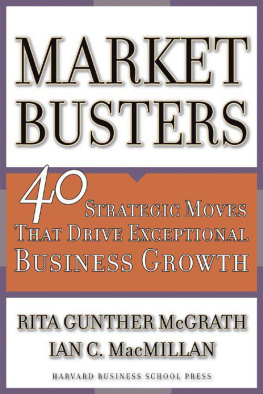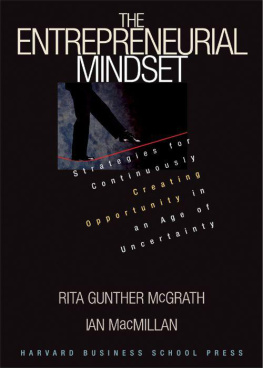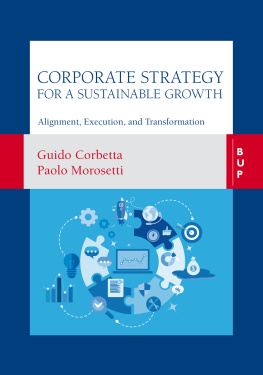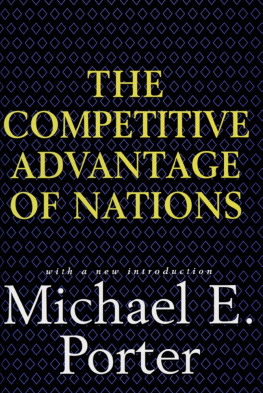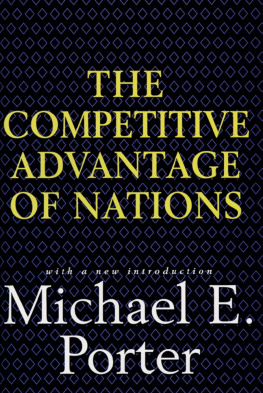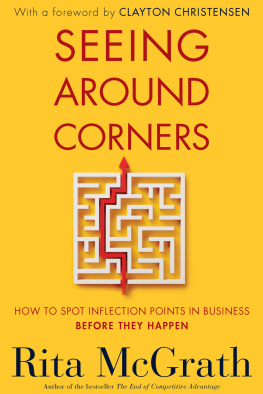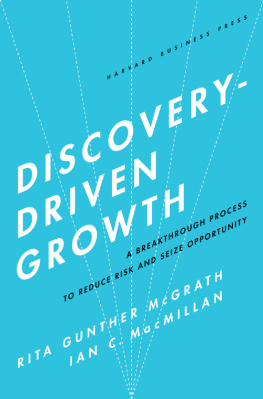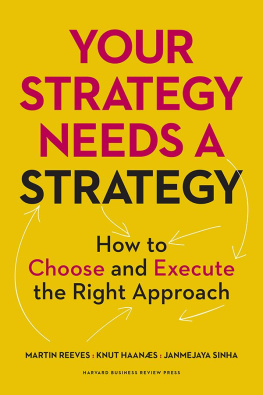Praise for The End of Competitive Advantage
The End of Competitive Advantage is an incredibly practical playbook for competing in todays dynamic world. Rita McGraths compelling book provides clear guidance for leaders searching for the competitive edges that seem to grow more elusive by the day. A must-read.
Scott Anthony, Managing Partner, Innosight; author, The Little Black Book of Innovation
Rita Gunther McGrath cements her status as one of the top business gurus in the world with The End of Competitive Advantage. She asserts that sustainable competitive advantage is obsolete and offers a thoroughly compelling argument that successfully managing waves of transient advantage is the future of business success.
John Caddell, author, The Mistake Bank (forthcoming)
In todays economy, committing to achieve sustainable competitive advantage is like building the Maginot Line: It locks you into a position from which it is hard to move, and it does not keep the bad guys out. Better instead to adopt Rita McGraths playbook for exploiting transient competitive advantages and get your organization to embrace the fact that the only constant is change.
Geoffrey Moore, author, Crossing the Chasm and Escape Velocity
How do you strategize when sustainable competitive advantages are gone? You need a playbook for strategy that fits todays fast and uncertain world. You need new methods for organizing and acting to deliver continuous growth and profits over decades. You need a new competitive advantagethis book.
Alex Osterwalder, entrepreneur and cofounder, Strategyzer.com
McGraths central insight is authentic, empirical, and profound. Too many organizations unicorn-hunt for sustainable competitive advantage at the expense of investing in agileand anticipatorystrategic opportunities. This book will provoke useful arguments around creating versus exploiting innovation opportunism.
Michael Schrage, Research Fellow, MIT Sloans Center for Digital Business; author, Who Do You Want Your Customers to Become?
If competitive advantage was ever sustainable, that time has passed. McGraths book not only captures the shortcomings of traditional, static models, but lays out the tools that fuel leading performance. The End of Competitive Advantage will give you an entirely new perspective on how to think about strategy.
Francisco DSouza, CEO, Cognizant
This smart, readable book addresses todays most significant strategy reality: that we are living in an era of transient advantage. Rita McGrath provides a playbook for this new landscape, showing how you can identify opportunities fast, execute against them at scale, and be unafraid to move on when the situation changes.
William D. Green, former Chairman, Accenture
The urge to hold on to ones established competitive advantage is a vicious trap. McGrath clearly establishes the factors central to building a dynamic competitive edge for an enterprise of tomorrow. Refreshing, insightful, and a must-read.
Sanjay Purohit, Senior Vice President, Infosys Ltd.
McGraths groundbreaking work is aptly timed for todays dynamic markets, where winning requires continuous reconfiguration.
Nancy McKinstry, CEO and Chairman, Executive Board, Wolters Kluwer nv
The End of Competitive Advantage makes clear that high-performance teams have to stay vigilant. Are your leaders seizing new opportunities or just trying to optimize an outdated strategy? Keep your head up and stay alert, or a transient advantage might pass you by.
Klaus C. Kleinfeld, Chairman and CEO, Alcoa
As a long-time member of the Rita McGrath fan club, I was delighted to see this book. Her approach to strategy is fresh and practical, and is exactly what managers need today. It acknowledges competitive realities but shows a clear path forward. It is one of the most illuminating takes on how to deal with disruption that I have ever read.
Clayton M. Christensen, Kim B. Clark Professor of Business Administration, Harvard Business School
Copyright 2013 Rita Gunther McGrath
All rights reserved
Printed in the United States of America
10 9 8 7 6 5 4 3 2 1
No part of this publication may be reproduced, stored in or introduced into a retrieval system, or transmitted, in any form, or by any means (electronic, mechanical, photocopying, recording, or otherwise), without the prior permission of the publisher. Requests for permission should be directed to , or mailed to Permissions, Harvard Business School Publishing, 60 Harvard Way, Boston, Massachusetts 02163.
The web addresses referenced in this book were live and correct at the time of the books publication but may be subject to change.
Library of Congress Cataloging-in-Publication Data
McGrath, Rita Gunther.
The end of competitive advantage: how to keep your strategy moving as fast as your business/Rita McGrath.
pages cm
Includes bibliographical references.
ISBN 978-1-4221-7281-0 (alk. paper)
1. Strategic planning. 2. Competition. I. Title.
HD30.28.M38378 2013
658.4012dc23
2012051721
ISBN13: 9781422172810
eISBN: 9781422191415
You jolted me from complacency in my nice little bureaucratic job.
Said that if it were a top five school the PhD would be worth doingotherwise not.
We started a family, left the city we both loved, moved away from our friends, and got a mortgage.
I was miserable. Transitions are hard.
But we went on to build something quite remarkabletogether.
For John, and discovering what our next chapter holds.
Contents
Foreword
This book could not be more timely. Any leader seeking to understand what it takes to win in the ruthlessly competitive markets most of us are faced with today will benefit from reading it. In my thirty-two years as a retailer (beginning as a Saturday boy at Boots in Glasgow), I have personally witnessed a dramatic acceleration of the pace of change and the upending of assumptions we used to take for granted. Shopping behavior is changing dramatically. We are witnessing the end of advantages that made our 163-year-old Boots brand iconic. Consumers give businesses less permission to be wrong than ever before, and the Boots brand is not immune to this shift.
We were first introduced to Ritas ideas when Boots Group merged with Alliance UniChem in 2006 to form Alliance Boots, and the breathing room that followed allowed us to take this newly formed company private in 2007. At that time we decided to transform the organization in a way that would enable us to operate very differentlyby putting our customers first. Working with Rita, who is a gifted and original strategic thinker, we sought to embed many of the principles presented in this book into the leadership mind-set of our new organization. And we continue to do that today. We seek to be quicker and more decisive. We seek to be more candid, so that pending newseven negative newstravels fast and is immediately addressed. We seek to spend more time thinking about the future than we ever have before. We seek to break down silos so that our organization is appropriately structured to capture opportunities and act as one unified entity. Most of all, we seek to create courageous leadersleaders who regard the fast pace of competitive exchange as exciting and who are fully engaged in creating an organization that can boldly capture opportunities and just as boldly move away from strategies and business practices that no longer represent opportunities.
When we started our evolution, many observers were skeptical. The Boots brand was tired and undervalued, they said, and the strategy poorly explained and not all that well executed. Moreover, our new business model, which combined a business-to-business wholesale operation with a customer-focused retail business, had seldom proved to be successful. But our results have proven our critics wrong. Measures assessing the recognition of our brand, satisfaction of our customers, and engagement of our employees are at record levels, and the profitability of Alliance Boots has been increasing by at least 10 percent every year since its privatization. And all this was achieved despite the global recession.


